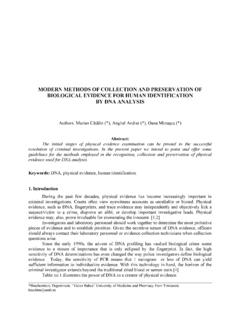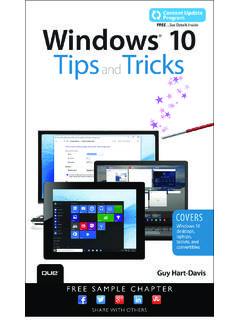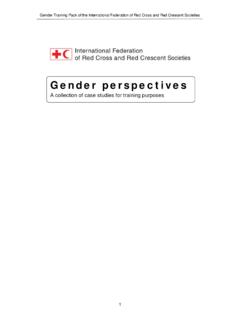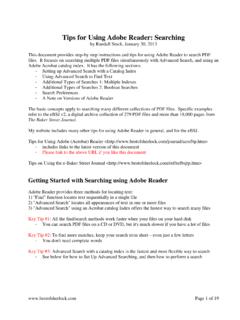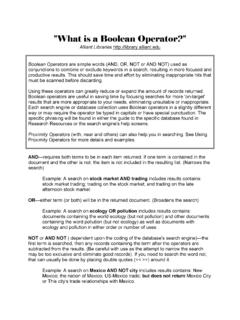Transcription of Cytology Sample Collection and Preparation for Veterinary ...
1 1 Since the mid 1960s, when the first reports of Cytology appeared in the Veterinary literature, Cytology has become an extremely useful diagnostic aid in Veterinary medicine. Cytology has many advantages over histopathology: Cytology samples can be easily obtained pre-operatively, often without general anaesthesia and sometimes even without sedation, and can be used to screen patients for more comprehensive diagnosis. Fine needle aspiration Cytology is less costly than surgical biopsy in both Sample Collection and laboratory analysis. The fine needle aspiration procedure is less likely to result in adverse effects when compared to tissue biopsy. Because less Sample processing is required, Cytology results are available sooner than histopathology results.
2 Quick checking for recurrence of local malignancies or regional lymph node metastases. Pathologic micro-organisms involved in microbial infections of various organs ( , canine and feline leprosy, subcutaneous mycoses, bacterial prostatitis) diagnosed initially by Cytology have a greater chance of being cultured successfully. Techniques are being developed whereby the aspiration of neoplastic lymphoid cells from suspected malignant lymphomas can be immunocytochemically phenotyped into T & B cell populations either directly from FNA smears of lymph nodes or via flow cytometry - thereby avoiding costly and sometimes contraindicated general anaesthesia to perform an incisional/excisional surgical biopsy.
3 Cytology aspiration of particularly hard to get to organs ( , pancreas, heart base), can be successfully sampled with the use of ultrasound guided , Cytology also has its limitations. As the cells/material being evaluated are outside their normal environment, an assessment of cellular organisation, arrangement or architecture is often not possible by Cytology . Therefore, adequate Sample Collection and Preparation is of considerable importance when it comes to cytological interpretation, as this will provide the pathologist with as much information as possible on which to base an Collection and PreparationWith Cytology , unlike histopathology, it is the clinician s responsibility to not only collect the specimen appropriately, but to adequately prepare the specimens that are to be presented for cytological of the experience of the clinician or Veterinary pathologist examining the smears, poor Sample Collection and Preparation will most likely result in interpretations or diagnoses such as, Open , Equivocal or Non-Diagnostic.
4 Improving the quality of cytological submissions will maximise the likelihood of a meaningful cytological description and a more accurate cytological diagnosis. Even if a definitive cytological diagnosis cannot be made, cytological findings may be of value in determining which additional diagnostic laboratory tests may be of further value ( , histopathology or culture) or directing further investigative procedures such as ultrasonography or radiography ( , when skin lesions may be involving bone or joints).It is extremely frustrating for clinicians and owners alike, when submitted cytological samples are non-diagnostic. Our aim here is to outline the basic principles of cytological Sample Collection and Preparation , and to provide advice on ways to reduce the frequency of non-diagnostic cytological results.
5 In our experience, cutaneous and subcutaneous lesions are the most commonly sampled for cytological evaluation and, therefore, where appropriate in this article, we have preferentially addressed Collection and Sample Preparation techniques from such lesions. However, many of the comments that follow are relevant to all aspects of Veterinary Cytology specimen Collection and Sample Collection and Preparation for Veterinary PractitionersDr Brett Stone and Dr George Reppas2 Cytology Collection Methods1. ImprintsTouch imprints may be made directly from crusted and ulcerative skin lesions or from impressions of deeper surgical biopsies gently rolled onto a glass slide prior to placement in formalin. Dry scabs/crusts should be removed manually prior to impression smears being made, as cells in these scabs/crusts will generally reveal poor cellular morphologic preservation and poor staining characteristics.
6 The tissue should be blotted dry (using paper towel) to remove surface fluid or blood as these may impair adhesion of cells to the slide and dilute the cytological material. Following this, the biopsy Sample or lesion being examined is firmly pressed several times onto a clean glass slide. Do not rub the tissue on the slide, as this will result in distorted cellular morphology by causing cell rupture and nuclear stranding. Imprints from ulcerative lesions often only yield superficial inflammation and infection and any underlying/primary neoplastic process may be missed. This is a good technique for investigating the presence of inflammation with or without infectious agent involvement, and it may also be useful in assessing the presence of superficial neoplasia such as that often seen with squamous cell ScrapingsThe back (blunt edge) of a scalpel blade or edge of a glass slide is used to gently scrape across the lesion or tissue biopsy until a small amount of material is collected.
7 This material is then gently spread/buttered across a slide (see Preparation of Slides). This method has similar uses to imprinting, but may also be used where imprinting is likely to yield too few cells for complete assessment ( , conjunctiva, mesenchymal neoplasia).3. SwabsThis technique is useful for the sampling of fistulous tracts, ear canals, exudates and for vaginal Cytology . Unless the location is very moist, lightly moistening the swab with 1 or 2 drops of sterile saline prior to Collection is advised, as this will minimise cell damage. Once the area to be investigated has been sampled by using the moistened swab, smears are prepared by gently rolling the swab over a glass slide. Do not smear the swab on the slide in a side-to-side motion as this causes cell rupture and poor cell preservation.
8 4. Fine Needle Biopsy/Fine Needle Aspirate Biopsy (FNAB)The best and most commonly used method for sampling proliferative lesions and masses. We recommend using a 22-25 gauge needle and a 2-5 ml syringe, and as a general rule, the softer the tissue, the smaller the needle and syringe required to obtain an adequate HeaviestMaking quality smears of impression smearsMaking quality smears of tissue scrapingsMaking quality smears with cotton-tipped swab2 slides, 4 touches/slide different degrees of procedure: Once the mass is stabilised between the operator s fingers, the fine gauge needle is inserted into the mass. When the needle is seated comfortably in the mass, negative pressure is applied to the plunger/syringe.
9 Try to avoid redirecting the needle or moving it back and forth within the mass whilst vacuum (negative pressure) is applied, as this generally results in increased blood contamination of samples . This procedure should be repeated at least 3 4 times at different angles within the lesion to obtain a representative cell population from the lesion in question. Smaller syringes attached to the needle offer the operator better control during the aspiration process, particularly when aspirating smaller lesions. A minimal amount of material within the hub of the needle is adequate and generally, this is sufficient for cytological interpretation. Attempted further aspiration often leads to unwanted blood contamination.
10 If blood is encountered during aspiration attempts, then the exercise should be ceased and repeated a little further away from the initial puncture site. Negative pressure should be released before the needle is removed from the mass and skin. Once the needle is removed from the syringe, air is drawn into the syringe and the needle is firmly re-attached to the syringe. The material within the hub of the needle is then expelled onto a couple of slides for smear Preparation as described procedure:This technique also utilises a fine gauge needle (22 25 g). Here a syringe is not attached to the needle for aspiration of skin masses. The needle is briskly redirected within the mass at several different angles.
